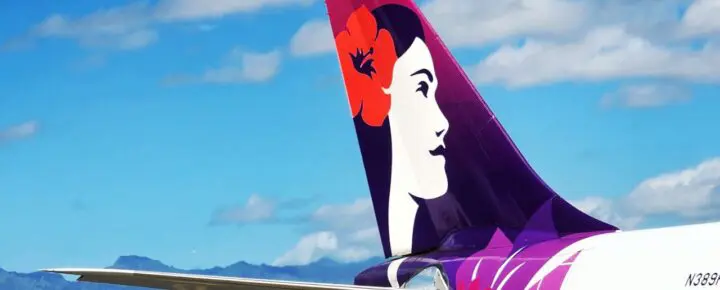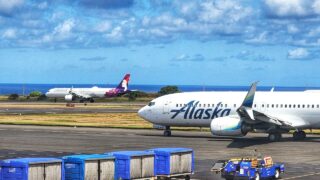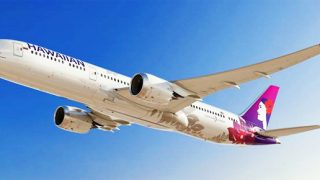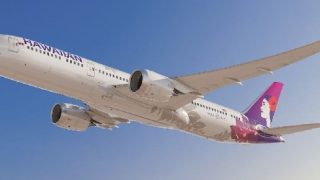You never forget the moment you see the Pualani on the tail at JFK, at Sydney, or Sea-Tac. For those who live in Hawaii, and for those island aficionados who return year after year, that image stirs something and always has. It is more than a logo. It is home. Or the place you love most. Hawaiian Airlines has always carried special meaning that goes far beyond mere transportation.
The downfall of Hawaiian Airlines wasn’t just a financial story.
For many, this unraveling has been especially difficult to witness, because it isn’t just about what happened to a company, but about what is being lost in identity, in purpose, and in the experience that once defined it.
The story that followed was never just about aircraft. It was about decisions made too late, leadership that clung to an outdated playbook, bets placed in the wrong places, and a stubborn refusal to adapt when everyone else already had. The widebody fleet didn’t break the airline on its own. It just made every other problem harder to fix.
What happened was slow and avoidable, a breakdown that left Hawaiian boxed in between unsustainable plans that included oversized jets, outdated interisland planes, and international markets that never came back.
A late pivot that never landed.
While other airlines, including Hawaiian’s new owner, Alaska Airlines, have long relied on narrowbody efficiency for island flights, Hawaiian tenaciously stuck to big planes. United, Delta, and American had been flying primarily single-aisle to Hawaii for years. And Alaska had actually built its entire Hawaii playbook on them.
But Hawaiian held onto its 767s, then doubled down with a fleet of 24 A330s, believing that widebodies could somehow carry its future. In fact, the company only began taking delivery of its first narrow-body A321neos in 2017.
By then, it was largely too late. Alaska was already carving out a massive West Coast-to-Hawaii network with strong frequency and lower costs. That model worked. Hawaiian, meanwhile, was flying large aircraft on routes that no longer fully supported them and holding onto a brand vision that didn’t match the Hawaii air travel market.
As one BOH reader put it, “Everyone else had already figured it out. Hawaiian thought they could play a different game. I don’t know how they ever thought that would work.”
Covid and the international collapse sealed the gap.
The pandemic didn’t create Hawaiian’s challenges, but it exposed them. Japanese visitor traffic, once among the airline’s crown jewels, collapsed in 2020 and remains deeply depressed to this day. Korean service has been pulled back. Starting in November, Hawaiian will no longer fly to Seoul, which it has been flying to for nearly fifteen years, most recently five times weekly. Even flagship routes like Boston have recently been eliminated, while New York’s status remains uncertain.
Rather than revamp, Hawaiian held on. It kept flying loss-making routes. It has kept its aging Boeing 717s in service for interisland flights, with no clear plan to replace them even now. And it proceeded with deliveries of Boeing 787 Dreamliners, adding a completely different wide-body type, with all the associated costs, but without the demand to support it.
Another BOH reader said it plainly: “The airline that ordered the Dreamliners in 2018 died in 2019. Alaska just bought the carcass in 2024 and took it to the rendering plant.”
The planes didn’t fail. But the business plan did.
Neither the A330s nor the 787s were inherently bad choices. They are used by major airlines worldwide. However, the difference lies in how and where they’re flown. Delta, United, and American operate wide-body aircraft on Hawaii routes that justify their use based on distance, premium demand, or cargo. Hawaiian did not. And it continued to fly those planes even as yields dropped and margins disappeared.
One longtime flyer told us, “We flew the A330 for years. It always felt like Hawaii started in the sky. Last month on an A321neo? Tight, noisy, and not a drop of Aloha.” Another added, “First class on the Hawaiian Dreamliner was incredible. Losing that makes the flight feel like just another trip.”
But emotional connection doesn’t help pay for fuel, crews, or airplanes. Hawaiian was bleeding cash. Its wide-body model demanded a kind of market that no longer existed.
Alaska didn’t cause the problems. They are merely cleaning them up.
Alaska Airlines didn’t do anything revolutionary. They flew the same narrowbodies everyone else did. But they did it with financial discipline, a quality, albeit different product, consistency and a clear understanding of the market. They didn’t try to make Hawaii into something bigger than it is. They flew where demand was real, kept costs low, and built loyalty around frequency, reliability, and direct-to-neighbor island flying.
They also got there long before Hawaiian did. While Hawaiian was still running long-haul flights with legacy aircraft, primarily through Honolulu and Maui, Alaska built up its Hawaii business with a single aircraft type (737) and a unified approach. The A321s that Hawaiian finally added, years later, came arguably too late and were never enough to reverse the broader established trend.
In Hawaiian’s Widebody Gamble Is Over, we said this merger was never about expansion. It was about recovery. The Dreamliners weren’t staying, and that was obvious. The A330s would be kept only as long as they were useful and on routes that justified them. And the future of Hawaiian mainland routes would need to be flown largely on narrowbody jets. Just like everyone else does.
A brand that couldn’t outrun the numbers.
Many passengers still associate Hawaiian Airlines with a particular kind of idyllic experience. Mood lighting. Boarding music. Island hospitality. For many, it felt like the vacation started the moment they stepped on board. Count us among them. However, the business no longer supported Hawaiian’s model.
In The Dreamliner Was Hawaiian’s Future. Now It’s Gone, we documented how quickly those planes disappeared from Hawaii-focused service. The rebranding of the entire 787 fleet, once unthinkable, is already underway.
One frequent flyer told us, “Passengers were sold an airline built around Hawaii. Now they’re boarding a Dreamliner plane with no mention of it.”
And that’s the deeper loss. Not the aircraft. The identity.
None of this should come as a surprise.
From the beginning, we said Hawaiian’s strategy was no longer sustainable. And when no one else stepped forward, Alaska did. They were the only carrier willing to take on Hawaiian’s nearly $1B in debt, its aging fleet, and the myriad complexities that came with the airline. For that, Hawaii may owe Alaska some real gratitude.
Alaska didn’t cause Hawaiian’s decline. They inherited it. And now they’re doing what Hawaiian couldn’t: right-size the fleet, reposition the brand, and operate with a sound business model that actually works. It may not be emotional, or what Hawaii aficionados had hoped for, but it’s grounded in reality.
That doesn’t mean they’ve been perfect. Alaska made promises to the DOT about maintaining a dual brand and preserving a volume of flights that may or may not hold up long-term. Whether they’ll need to revisit those commitments remains to be seen. Markets shift quickly. And so far, their messaging hasn’t always matched what’s happening on the ground.
The Dreamliners were never going to stay in Hawaii, whether through Alaska or bankruptcy. The A330s will remain here so long as they make sense, and on routes that justify them. Widebody planes, after all, are tools, not trophies. Every major airline, including Alaska, knows that.
The 737 MAX will form the core of the new fleet, as that’s who Alaska is. The A321neos will likely stay because they’re owned and efficient. None of this is controversial. It’s simply what Hawaiian should have done years ago.
We welcome your input on Hawaiian Airlines. Mahalo!
Get Breaking Hawaii Travel News







I have read your article and would like to present to you a partial rebuttal of your points. Some of the points, as I have written, were valid. However, some points needed to be fleshed out, such as the devaluation of the Yen, which was a significant factor. There were also factors I didn’t mention in the piece, such as. The disruption of the construction at HNL during the reopening delayed services by the airline. I present my piece to you respectfully here.
politicshawaii.com/hawaiian-airlines-didnt-fail-the-world-changed-around-it/
Thank you.
Great, broad overview of Hawaiians decisions over the years that brought us to this point. Perhaps this will help many readers understand that their love of a widebody flight does not a successful airline make. I also cringe when a reader rants that now that they can’t fly a Hawaiian widebody from PHX or SAN they just won’t come to Hawaii anymore…??? Maybe we don’t need them, that is just so insane. There still is widebody service to Hawaii, its just from markets that demand the capacity not only in pax volume but in cargo volume as well.
As far as the 717 fleet being outdated, I’m going to disagree. As long as they aren’t completely out of cycles, including extending their cycle life, they are the best plane available. If HA had tried to replace the 717 5-7 years ago at the same time they ordered the 787, there would have been no HA for AS to buy. The only economic replacement for the 717 is a 717 with less cycles (ex-Qantas) or used E-175/195. Please, no SkyWest!
It’s been painful to watch. With Boston being my home airport and ever rising prices, my October trip will likely be my last to the islands for a long time. As soon as I’m home in Boston I’m going to call Barclays and see if I can switch to a JetBlue cc instead of keeping my Hawaiian one. No point in paying a yearly fee for benefits I’ll no longer be able to take advantage of. I’ll just start taking quick dive trips down to Florida instead of week long ones in Hawaii.
Wow so many complimenting this article. Lets give a dose of reality from those who live here.
I live in Maui and watched the whole thing like over a million other people in the Islands did.
Let’s begin with the real reason: Covid
Covid changed the entire industry in Hawaii. Period.
Everything HA was forced to do from that moment is why they were driven toward bankruptcy.
The entire Asian market collapsed which was reason for buying Dreamliners etc.
The A330s were packed before Covid. The interisland flights were sold out. The West coast flights were booming. Hawaiian was expanding to Asia. Not North America in a big way.
Covid killed everything in the Islands. Yes, part of the blame goes directly on the insane closure of Hawaii by a ignorant foolish Hawaii government shutdown.
So let’s realize no other Airline depended on Hawaii as its home base, and state to survive during or after Covid.
The losses were too much to overcome. Billions lost.
More details later.
Tomorrow, Wednesday, August 20, 2025 is the first day you should be able to sign-up for the new Alaska Airlines and BofA-issued Atmos Rewards Summit Visa Infinite Credit Card…that’s a mouthful!…lol
BofA’s relationship with Alaska goes back to the 1980’s as SeaFirst Bank.
I have to use a corporate card for my business travel, but am able and do participate in Membership Rewards – so at least I earn some points.
Infinites will only receive 2 passes each quarter to the Alaska Board Room – so as a 100K with Lounge Plus +, I shouldn’t have to be concerned about overcrowding from all the new Infinites running amok in the Board Rooms.
Are any of the HA Barclay credit card holders cutting up their cards? Suggestion – don’t do that – it looks bad for your FICO. Ask Barclay’s for a downgrade to another card…maybe Frontier…lol
I fault HA’s slow downfall on the disastrous change from Sabre (originally started and owned by AA) to Amadeus. HA literally went from a PSS/GDS system that can be compared to a Lexus, downgraded to cart without a horse!
The other dumb thing HA’s management did was removing inter-island flights for sale from all the GDS’s that travel agents and corporate travel departments use. Alaska quickly reinstated the ability to sell those flights!
For the next few years, I expect AS to keep the A330’s until the leases expire and/or it’s time for the hugely expensive “C” checks and overhauls.
Overall, the 717’s have a few years left. To fulfill D.O.T. commitments, I expect AS to operate a few 737-700’s and a 737 all cargo aircraft.
For those who really hate AS and everything they are doing to poor innocent HA – shortly, you’ll be able to fly AA and credit your miles to Atmos without having to set foot on any AS aircraft!
The article mentioned this but without diving deeply into the yen to usd value literally flipping 40 to as high as 50 pct during the pandemic. It’s still 140 yen to 1 usd which wasn’t the case in 2018 when those Dreamliners were purchased. The fact that it cost that much more for a long haul Japanese tourist to visit literally killed that segment. Plus alaska was doing 99 dollar yearly companion fare and that made it much more competitive than flying Hawaiian from the mainland. Don’t get me wrong I prefer Hawaiian back in the day as it was the only domestic airline offering a free meal (and it was good) but the other carriers made it too competitive combined with macro economic factors.
That said I always prefer Hawaiian. Something about that logo makes it different for me
Wow, finally an article that isn’t “woe is me” (Hawaiian airlines) I would say most all of the articles I’ve read on this site put Alaska as the villain for bailing out Hawaiian.
I get it, it’s tough when you lose something near and dear. Heck, we Seattle are still not over Howard Schultz selling our Sonics!
I don’t think Alaska will be a bad thing just need to give it time.
So aptly put, “Widebody planes … are tools, not trophies.”. Thank you for an insightful article!
The part that bothers me, the Top Dog of Hawaiian Air walked away with $13+m along with other execs getting their sweet Aloha pay. For what, making disadvantageous decisions?
Yet the ones who do the actual hard work get what, peanuts and the ’till we meet again’ Aloha.
Annoying at best.
Again, your article underlines the fact that the Japanese\Asian market was key to whoever was operating an airline in Hawaii. Plus once they got here they would outspend West arriving tourists 3-1. We’ll have to see if Hawaiian can survive and keep some form of identity after the merger has shaken out. Hope so.
Excellent article and comprehensive analysis of what has happened to Hawaiian Airlines. Also, one cannot overlook the horrible management of the Covid pandemic by Hawaii’s incompetent state government that locked up the islands for over two years and nearly killed the tourist economy. You can’t fill airplanes when people are prohibited to travel without draconian steps to make the trip.
Great article
And so now we no longer have Any local focused inter-island jet service. I wonder whether this is our “forever future” or if this opens up a niche for a tightly operated and highly locally focused inter-island start-up to actually succeed. In my 45 years here I’ve seen several try but no one has succeeded yet.
The economics of interisland jet service are abysmal. When you factor in the cost of aircraft, fuel, salaries, and infrastructure, the numbers simply do not align with what the local market can afford. Hawaii is a unique case, where so much of the state infrastructure is located on O’ahu, and residents of the neighbor islands often need to travel there for medical appointments. We don’t have an alternate form of transport.
I see two possible solutions, both of which are highly unlikely.
1. Set airfares at the true operating expense + profit margin, and then offer a hefty discount for local residents.
2. Apply for Essential Air Services (EAS) subsidies
I have no idea what the actual break-even point would be, but whatever it is, my guess is that we’d see what we saw in the past – except worse, now that Alaska owns Hawaiian – cut-throat price competition from Alaska that would effectively bankrupt any upstart (I think SWA only survived because they were big enough to absorb whatever fare-war Hawaiian might have wanted to try)
Never forget the payouts to those that ran Hawaiian into bankruptcy-
CEO Peter Ingram- $13,200,000
CFO Shannon Okinawa- $4,900,000
COO Johnathon Alter- $5,400,000
CLO Aaron Alter- $4,200,000
But but but it’s really a dud way to fly to an from Hawaii.
You can downsize the plane itself. But for some reason, it seems that the atmosphere changed with it. The customer service and experience shouldn’t have changed. Now they are pitting customers against each other for leg room and personal space. Guess that is to draw attention away from the overall loss of what was Aloha. If you nickel and dime customers enough, they quit using your service. Maybe the airlines and Green are in agreement to reduce the middle class customer.
Well said…..the simple reality is Hawaii had only so much room for growth and Hawaiian had taken the market about as far as any one airline could. Continued growth like under the Dunkerley era was not realistic, Covid accelerated the process and the Alaska merger is the best solution for both. Without Hawaiian Alaska would not have been able to take the leap into Widebody International flying. I hope the potential of this merger is realized.
One of the best articles put out by BOH in ages!!!!
If you are a HA employee, and like your career, time to buy a house in SEA. Same price as Hawaii. Better schools for your kids and cost of living is less. You can always nonrev back a few times a year.
Plus no income tax in Washington!
I think if people want the wide body experience they should be willing to pay for it. I fly a Delta Airbus wide body plane from Arlanta GA to Honolullu. It cost a little more but worth it.
Hawaiian Airlines buying 24 Airbus 330 wide bodies reminded me of when Pan Am, the launch customer of the Boeing 747, ended up with 65 of them, and due to various factors could not pay the debt service and went bankrupt back in 1991. Both airlines tried to live up to their “emotional images” to satisfy passenger expectations, but failed. Economic reality rules.
Not to detract from your excellent piece, but just to add a little more background:
I would not necessarily add Hawaiian Airline’s decision to add 767’s as a mistake. I think to some degree, even back then, HA was between a rock and a hard place.
Aloha Airlines, having upgraded their 737-200’s to -700’s got something DC-9 world Hawaiian did not: ETOPS. Until AQ got ETOP’s capable planes, the 2 airlines competed on a more or less equal footing, getting interisland feed from the network carriers. When United started flying nonstop to the outer islands, the handwriting was on the wall. AQ and HA were no longer “partners” with UA, etc., but competitors and AQ with their ETOPs capable 737’s were better able to compete. HA chose to fight back with 767’s. Otherwise, they would have been squeezed from all directions.
That decision was qualitatively different than getting 24 (Jeeeez!) A330’s
Well done.